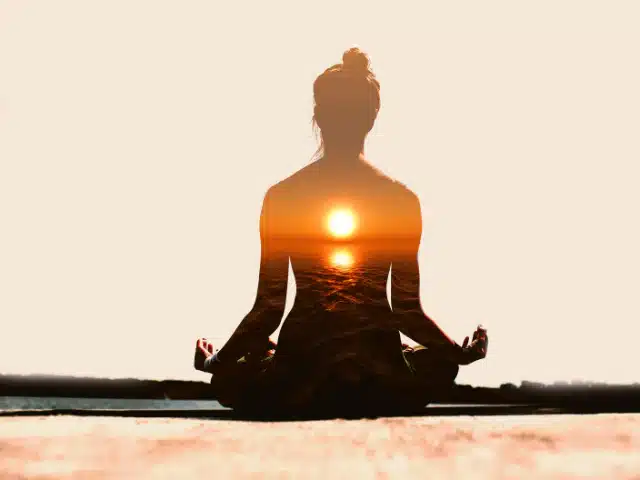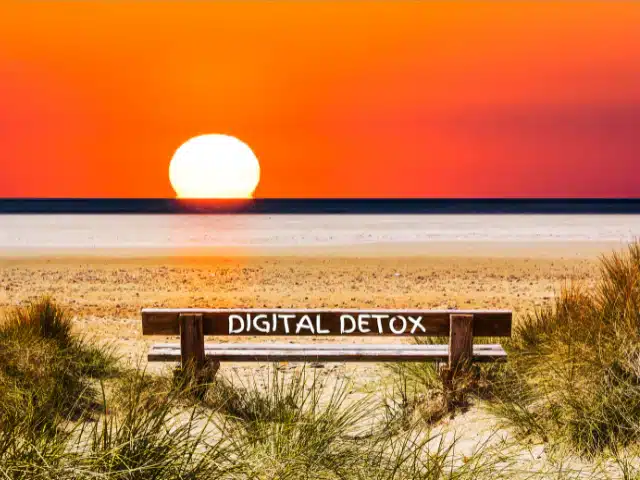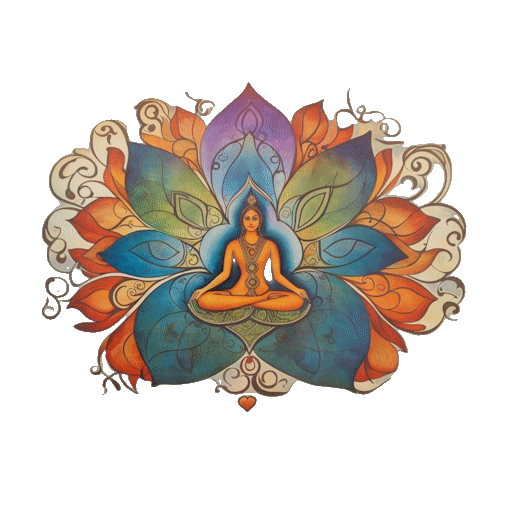In the intricate dance of life, where our thoughts sway and emotions whirl, lies a constant, guiding force: prana. This vital life force, deeply interwoven with our mind & well-being, is pivotal in our overall health. From the ancient art of meditation to the modern challenges of digital fatigue, from the mysterious narratives of dreams to the rejuvenating embrace of nature, our journey through mental well-being is a voyage of understanding, balancing, and enhancing our prana. As we delve into this exploration, we’ll uncover the myriad ways our mind, emotions, and practices influence this vital energy, guiding us toward holistic health and harmony.
Meditation: The Ancient Art of Mindfulness
Meditation, a practice as ancient as human civilization itself, has been a beacon of inner peace and self-awareness for countless generations. Rooted in diverse cultures, from the serene monasteries of the Himalayas to the tranquil Zen gardens of Japan, meditation has always been a pathway to connect with the deeper layers of our consciousness and, in turn, our prana.

Vipassana
Originating from ancient Indian traditions, Vipassana emphasizes the art of “seeing things as they really are.” It’s a process of self-purification through self-observation, allowing practitioners to experience the universal truths of impermanence, suffering, and the realization of self.
Transcendental Meditation (TM)
Popularized in the modern era by figures like the Beatles, TM involves silently repeating a mantra to dive deep into a state of restful alertness. This technique not only enhances prana but also brings about a unique state of brain function.
Zen Meditation (Zazen)
Rooted in the Zen Buddhist tradition, Zazen, or “seated meditation,” is all about observing the thoughts and sensations without attachment. It’s a practice of letting go, of finding stillness amidst the chaos.
In today’s fast-paced world, where distractions are but a click away, the rise of mindfulness practices offers a respite. Modern adaptations, like guided meditations and mindfulness apps, bridge ancient wisdom with contemporary needs, making meditation accessible to all. Whether it’s a few moments of deep breathing at your desk or a dedicated session in a quiet corner, meditation is a gateway to enhance our prana, bringing clarity, calmness, and a deeper connection to our inner self.
Emotional Wellbeing and Prana
Emotions, often seen as fleeting reactions to life’s events, hold a deeper significance when viewed through the lens of prana. Each emotion, be it joy, sorrow, anger, or love, carries with it a distinct energy, influencing our vital life force.

Understanding Emotions as Energy
Just as a calm lake reflects the sky with clarity, a balanced emotional state allows prana to flow freely. Conversely, turbulent emotions, much like stormy waters, can disrupt this flow. Recognizing emotions as manifestations of energy is the first step toward harnessing their power.
Techniques to Process and Release Emotions
Traditional practices, like journaling or talking therapies, offer a safe space to express and process emotions. Modern techniques, such as Emotional Freedom Technique (EFT) or “tapping,” combine ancient acupressure points with psychological tools to release emotional blockages, ensuring a harmonious flow of prana.
Role of Therapies in Enhancing Prana
Therapies, both traditional and contemporary, serve as bridges to our emotional core. Whether it’s the introspective journey of psychotherapy or the energy-balancing practices of Reiki, they aim to align our emotional state with our prana, bringing about healing, balance, and vitality.
In our journey through life, emotions serve as signposts, guiding us, teaching us, and reminding us of our shared human experience. By embracing our emotional landscape, by processing and releasing emotions, we not only enhance our mental well-being but also ensure that our prana remains vibrant and free-flowing.
Modern Stress and its Impact on Prana
Modern life, with its deadlines, digital distractions, and societal pressures, stress has become an unwelcome companion for many. While stress, in small doses, can be a motivator, chronic stress can be a silent disruptor of our prana.

Challenges of Modern Life
The 24/7 connected world, while offering conveniences, also blurs the boundaries between work and rest, public and private. The constant barrage of notifications, the pressure to keep up with societal standards, and the race against time all contribute to heightened stress levels.
Physical and Mental Impact
Chronic stress doesn’t just weigh down the mind; it has tangible effects on the body. From sleep disturbances and digestive issues to anxiety and mood swings, the repercussions of unmanaged stress can be far-reaching.
Techniques to Combat Stress
- Mindfulness and Meditation: Grounding oneself in the present moment, and observing thoughts without judgment, can offer a sanctuary from the whirlwind of stress.
- Physical Activity: Whether it’s a brisk walk, a session at the gym, or a dance class, moving the body can release pent-up stress and enhance prana.
- Hobbies and Creative Outlets: Engaging in activities that bring joy, be it painting, reading, or gardening, can serve as a buffer against stress.
- Deep Breathing: Simple yet effective, taking deep, conscious breaths can calm the mind and regulate the body’s stress response.
- Somatic therapy: Modern life brings many stressors that can disrupt our prana, or vital life energy. Techniques like somatic therapy can help manage and reduce this stress.
The Importance of Self-Care
In the quest to meet external demands, self-care often takes a backseat. Yet, setting aside time for oneself, establishing boundaries, and prioritizing mental well-being is crucial for maintaining a harmonious flow of prana.
In the face of modern challenges, it’s essential to remember that we hold the power to shape our experiences. By recognizing stressors, equipping ourselves with coping techniques, and prioritizing our well-being, we can navigate the modern maze with grace, ensuring that our prana remains vibrant and resilient.
You Might Also Like:
Sound Healing and Vibrational Therapies
Sound, a fundamental aspect of our universe, has been harnessed for healing and spiritual practices for millennia. It has always been a conduit for connecting with the deeper realms of consciousness and prana.

The Ancient Practice of Sound Healing
Ancient civilizations, from the Greeks to the Egyptians, recognized the therapeutic potential of sound. Instruments like gongs, bells, and bowls were used in rituals to invoke divine energies and restore balance.
Modern Practices and Their Impact on your mind & well-being
- Binaural Beats: By playing two slightly different frequencies in each ear, binaural beats create a third tone that can enhance relaxation, meditation, stress reduction, and even sleep.
- Singing Bowls: Originating from the Himalayan regions, these bowls, when struck or circled with a mallet, produce resonant tones that can align and balance the body’s chakras.
- Sound Baths: Immersive experiences where participants are “bathed” in sound from gongs, crystal bowls, and other instruments, leading to deep relaxation and healing.
The Science Behind Sound Frequencies
Modern research suggests that sound frequencies can influence brainwave patterns. For instance, delta waves (1-4 Hz) are associated with deep sleep, while theta waves (4-8 Hz) are linked to meditation and creativity. Sound therapies can help induce these beneficial states.
Harmonizing Prana with Sound
Just as a pebble creates ripples in a pond, sound vibrations can create ripples in our prana. By choosing healing sounds and frequencies, we can align our energy, clear blockages, and enhance our overall well-being.
Sound healing and vibrational therapies offer a bridge, connecting the seen with the unseen, the physical with the ethereal, and helping us tune into our inner prana with greater clarity and harmony.
Visualization and Guided Imagery
The mind, a landscape of thoughts, dreams, and imaginations, holds a potent tool: the power of visualization. By conjuring images, scenarios, and feelings, we can influence our reality, tapping into the reservoir of prana that lies within.
The Science of Visualization
Neuroscientific studies have shown that the brain doesn’t differentiate much between a vividly imagined experience and a real one. When we visualize, neural pathways are formed, preparing the body for the visualized action or outcome.
Harnessing Visualization for Healing
Many holistic practitioners use guided imagery to facilitate healing. By visualizing the body healing, cells rejuvenating, or pain dissipating, we can influence our physical state, enhancing the flow of prana.

Manifestation and the Power of the Mind
The concept of manifesting desires through visualization has ancient roots, with modern interpretations like the “Law of Attraction.” By holding a clear, positive image of our desires and infusing it with emotion, we align our prana with our goals, drawing them closer to reality.
Modern Applications:
- Sports: Many athletes use visualization to improve performance. By mentally rehearsing a move, they enhance muscle memory and boost confidence.
- Therapy: Guided imagery can be a powerful tool in therapy, helping individuals confront and process traumatic events in a safe space.
- Personal Development: Visualization exercises are often used in personal development seminars and workshops, aiding individuals in setting and achieving goals.
Enhancing Prana Through Visualization
When we visualize, we tap into our innermost desires, hopes, and fears. By aligning our visualizations with positive intentions and emotions, we can enhance the flow of prana, bringing about healing, manifestation, and personal growth.
Nature and Mental Wellbeing
Nature has always been a source of solace and inspiration for humankind. The rustling leaves, the gentle babble of a brook, or the majestic sight of a mountain range can evoke profound feelings of peace, grounding our prana and rejuvenating our spirit.

The Therapeutic Effects of Nature
Ever noticed how a walk in the woods or a day at the beach can lift your spirits? This isn’t just a fleeting feeling. Nature has tangible therapeutic effects, reducing stress hormones, improving mood, and enhancing cognitive function.
Practices to Connect with Nature:
- Forest Bathing (Shinrin-Yoku): Originating from Japan, this practice involves immersing oneself in a forest environment. It’s not about exercise but about being present, soaking in the forest atmosphere, and enhancing prana.
- Grounding: Walking barefoot on natural surfaces like grass or sand can help in grounding, believed to neutralize negative energies and enhance our vital life force.
- Nature Meditation: Meditating in natural settings, focusing on the sounds, sights, and sensations, can deepen the meditative experience and amplify prana.
Scientific Studies on Nature’s Impact
Research has shown that spending time in nature can reduce mental fatigue, improve concentration, and boost overall well-being. Natural settings can activate the parasympathetic nervous system, promoting relaxation and healing.
Nature as a Prana Enhancer
Beyond the physical benefits, nature connects us to the primal rhythms of life. The ebb and flow of tides, the changing seasons, and the life cycles of plants and animals all resonate with our inner prana, harmonizing and amplifying it.
You Might Also Like:
Digital Detox and Prana
In today’s hyper-connected world, our lives are intertwined with digital devices. While these tools offer convenience and connectivity, they can also inundate our senses, often leading to digital fatigue and a disruption in our prana flow.

The Digital Age’s Challenges
The constant barrage of notifications, the urge to scroll endlessly, and the pressure to stay updated can lead to mental exhaustion. This digital overload can cloud our judgment, reduce our attention span, and dampen our prana.
Benefits of Periodic Digital Detoxes:
- Mental Clarity: Disconnecting from the digital world, even for a short period, can bring clarity, allowing us to focus on the present moment.
- Enhanced Relationships: When we put down our devices, we engage more deeply with those around us, fostering genuine connections.
- Restored Prana: A break from the digital realm can recalibrate our energy, allowing prana to flow more freely.
Techniques for a Balanced Digital Life
- Scheduled Breaks: Setting aside specific times during the day when devices are off-limits can reduce digital fatigue.
- Nature Retreats: Spending time in nature, devoid of digital distractions, can rejuvenate the mind and enhance prana.
- Mindful Consumption: Being selective about the content we consume, choosing quality over quantity, can ensure a more enriching digital experience.
Optimizing Prana in the Digital Era
While it’s unrealistic to completely shun digital devices, mindful usage can make all the difference. By recognizing the signs of digital fatigue and taking proactive steps, we can ensure that our prana remains vibrant in this digital age.
Sleep, Dreams, and Prana
Sleep, often seen as a passive state of rest, holds profound significance for our well-being. It’s during these quiet hours that our body repairs, our mind processes, and our prana rejuvenates. Dreams offer insights into our subconscious, further influencing our energy flow.

The Importance of Restorative Sleep
Sleep isn’t just about shutting down; it’s a dynamic process where various physiological and psychological processes take place. From cellular repair to memory consolidation, sleep plays a pivotal role in ensuring our prana remains vibrant.
Understanding Dreams
Dreams, with their surreal landscapes and symbolic narratives, offer a window into our subconscious. They help process emotions, confront fears, and even offer insights, all of which can influence our prana.
Modern Challenges
- Insomnia: The bane of modern life, insomnia, or the inability to sleep, can severely disrupt our prana flow. Factors like stress, digital screens, and irregular routines often contribute.
- Sleep Quality over Quantity: It’s not just about the hours clocked in but the quality of sleep. Deep, uninterrupted sleep cycles are crucial for prana rejuvenation.
Solutions for Better Sleep
- Sleep Hygiene: Creating a conducive environment for sleep, like a dark, cool room, can enhance sleep quality.
- Digital Detox Before Bed: Keeping devices away an hour before bedtime can reduce sleep disturbances.
- Relaxation Techniques: Practices like deep breathing, meditation, or even reading can signal the body that it’s time to wind down.
Dreams and Prana
By paying attention to our dreams, by understanding their significance, we can align our subconscious with our conscious, ensuring a harmonious flow of prana.
Breathing: The Essence of Prana
Breathing is the fundamental rhythm of life, an act so natural that we often take it for granted. Yet, it holds the key to a treasure trove of energy known as prana. By cultivating a conscious breathing practice, we can navigate life’s stresses with greater ease, enhance our mindfulness, and foster a sense of inner peace and vitality.
Pranayama, an ancient yogic practice, is a profound pathway to explore the depths of breathing. It involves various techniques that harness the breath to balance and unblock our energy channels, promoting physical, mental, and spiritual well-being. Discover the transformative power of pranayama and its various techniques here.
Conclusion
The voyage of understanding our mind and well-being through the lens of “prana” is both enlightening and empowering. In a world where external stimuli constantly bombard us, where digital screens often overshadow natural vistas, and where the pace of life can be relentless, it’s essential to remember the intrinsic power of our prana.
From the ancient art of meditation to the modern challenges of digital fatigue, from the mysterious narratives of dreams to the rejuvenating embrace of nature, every facet of our existence influences our vital life force. By harmonizing ancient wisdom with modern techniques, by listening to the subtle cues of our body and mind, and by prioritizing practices that enhance our prana, we pave the way for holistic well-being.
As we conclude this exploration, let’s carry forward the insights, the practices, and the wisdom, ensuring that our prana remains vibrant, balanced, and harmonious. In the dance of life, let our prana be the rhythm, the energy, and the guiding force, leading us to a state of holistic health, happiness, and harmony.
FAQ
What is prana and how does it relate to mental well-being?
Prana is the vital life force energy that permeates everything. It’s closely linked to our mental well-being because our thoughts, emotions, and overall mental state can influence and be influenced by the flow of prana.
How can meditation enhance prana?
Meditation helps in calming the mind, reducing mental chatter, and bringing about a state of balance. This harmonious state facilitates a smoother flow of prana, enhancing our overall energy and vitality.
Why is sleep important for prana?
Sleep is a restorative process where our body and mind rejuvenate. A good quality sleep ensures that our prana is replenished, leading to increased vitality and balance.
How do digital devices impact our mental well-being and prana?
Excessive use of digital devices can lead to mental fatigue, stress, and sleep disturbances. This can disrupt the natural flow of prana, leading to imbalances in our energy.
What role do dreams play in our prana?
Dreams offer insights into our subconscious mind, helping process emotions and experiences. Understanding and integrating these insights can lead to a harmonious flow of prana.
Can nature enhance our mental well-being and prana?
Absolutely! Nature has a calming and rejuvenating effect on our mind. Spending time in nature can ground us, aligning our energies and enhancing the flow of prana.
What are some modern challenges to mental well-being and how do they affect prana?
Modern challenges include digital overload, stress, anxiety, and lifestyle imbalances. These can cloud our mental clarity and disrupt the flow of prana. However, with mindful practices and self-awareness, we can navigate these challenges and ensure our prana remains vibrant.
How does sound healing influence our prana?
Sound healing, using tools like singing bowls or binaural beats, works on the principle of vibrational frequencies. These frequencies can resonate with our body’s natural rhythms, helping to balance and enhance the flow of prana.
Why is emotional well-being crucial for prana?
Emotions are a form of energy. When we hold onto negative emotions or fail to process them, it can create blockages in our energy flow. Addressing and balancing our emotional state ensures a smooth flow of prana.
What is the significance of visualization in enhancing prana?
Visualization harnesses the power of the mind to influence reality. By vividly imagining positive scenarios, outcomes, or healing processes, we can align our prana with our intentions, amplifying its effects.
How can modern stressors deplete our prana?
Modern stressors, whether from work, relationships, or lifestyle choices, can put our mind and body in a constant state of alertness. This can drain our energy reserves, leading to a depletion of prana.
Is there a connection between digital detox and prana enhancement?
Yes, taking breaks from digital devices allows our mind to rest and rejuvenate. This break can recalibrate our energy, allowing prana to flow more freely and enhancing our overall vitality.
Can practices like Tai Chi or Qigong influence prana?
Absolutely! Tai Chi and Qigong are ancient martial arts that focus on the flow of energy or “chi” (akin to prana). Regular practice can harmonize this energy, leading to enhanced prana and overall well-being.


